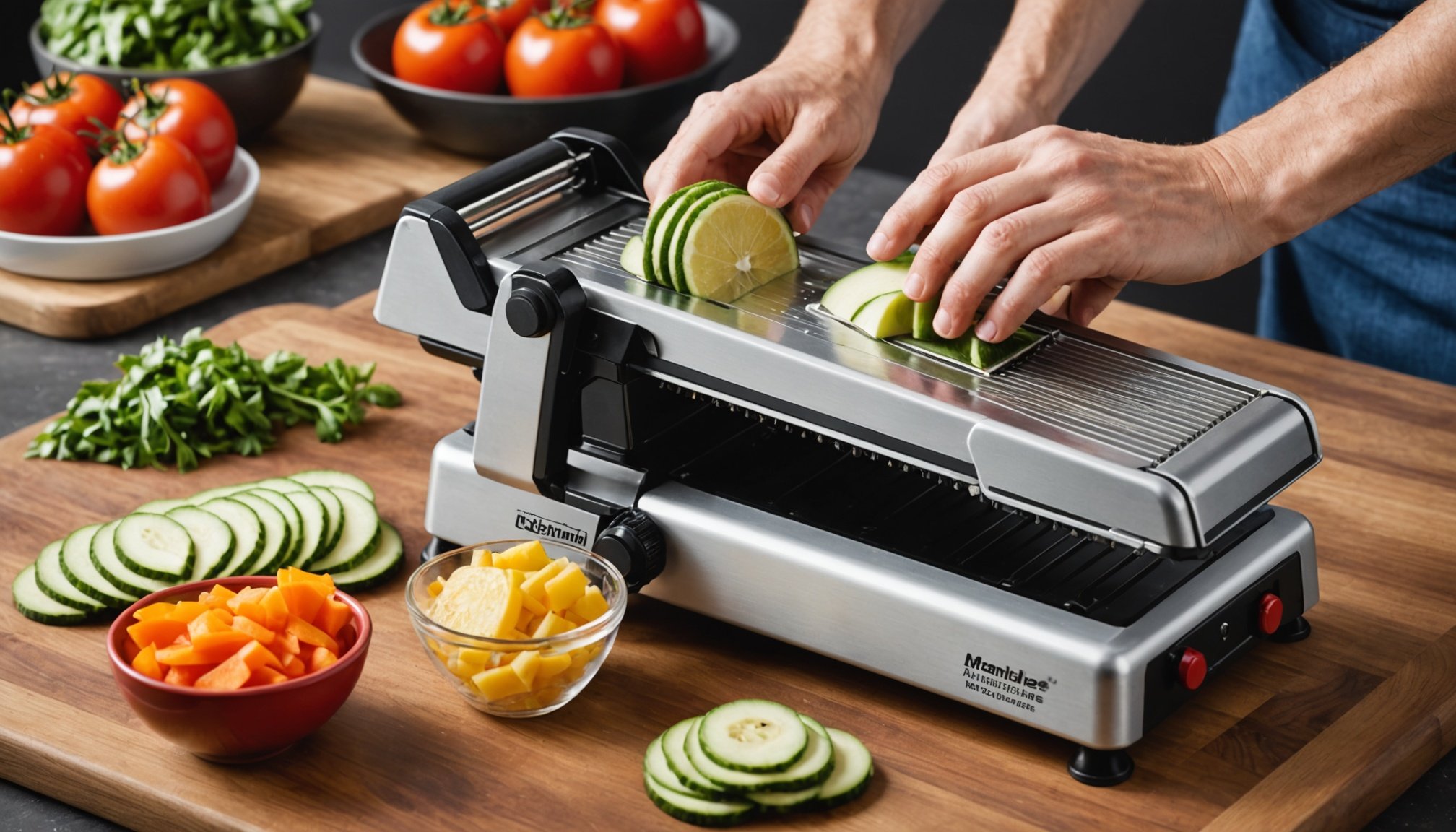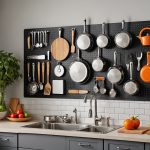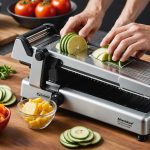Understanding Mandoline Slicers
Mandoline slicers are versatile kitchen tools designed to produce uniform slices of vegetables and fruits with efficiency and precision. These devices cater to both amateur cooks and professional chefs, simplifying the process of preparing complex dishes. The purpose of mandoline slicers is rooted in their ability to enhance food presentation while saving time.
There are various types of mandoline slicers available in the market, each tailored for specific needs and user preferences. Some common types include:
Also to read : Mastering fish scaling made easy: your ultimate guide to choosing the perfect quality scaler
- Fixed-blade slicers, known for their durability and straightforward use, offer a consistent slicing depth.
- Adjustable-blade slicers, which provide versatility through adjustable settings, allowing for different slice thicknesses.
- V-shaped slicers, which ensure even slicing, especially when dealing with hard vegetables like carrots.
Understanding how mandoline slicers work involves knowing their mechanism. Most utilize a sharp blade positioned on an inclined surface. The food is slid along the horizontal plane, meeting the blade at an angle that determines thickness. A hand guard is typically included to protect fingers from the sharp edge, promoting safety during use. This ingenious design integrates speed with safety, making it a practical solution for daily culinary tasks.
Key Features to Look For
When shopping for a mandoline slicer, understanding the features of mandoline slicers can significantly enhance your kitchen experience. A crucial aspect to consider is the adjustable blade thickness. This feature provides versatility, allowing users to slice vegetables and fruits to their preferred thickness, whether it’s for a delicate carpaccio or robust potato gratin. Control over slice thickness can elevate the quality and presentation of your dishes.
Also read : Effortlessly chop garlic without the mess: the ultimate guide to choosing your ideal uniform-style chopper
Material quality is another essential factor. Mandoline slicers are typically constructed from materials like plastic, stainless steel, or a combination of both. High-quality stainless steel models are known for their durability and resistance to rust, making them a long-lasting option. Plastic versions, although lighter and often less expensive, may not offer the same longevity. Therefore, opting for a slicer with superior material quality ensures consistent performance over time.
In addition to adjustable blade thickness and material build, consider other features that might enhance usability and safety, such as non-slip bases, easy-grip handles, and safety guards. These features of mandoline slicers contribute to a safer and more efficient slicing process, making the kitchen tool not only practical but also enjoyable to use.
Evaluating Reliability
Understanding the reliability of mandoline slicers is crucial for ensuring safety and performance in your kitchen. To assess reliability, consider several factors, such as user reviews and a brand’s reputation. These elements are clear indicators of a product’s dependability and durability.
User reviews play a pivotal role in the decision-making process. They provide firsthand accounts of a mandoline slicer’s performance. Customers frequently mention the slicer’s construction, longevity, and ease of use. When browsing reviews, pay attention to repeated themes or issues, as these often highlight genuine reliability concerns or endorsements.
Ratings, often on a scale from 1 to 5, also offer a quick snapshot. A higher aggregate score generally signals a more reliable product, though it’s essential to read the accompanying comments for context.
Brand reputation should not be overlooked. Companies recognized for their quality typically maintain high reliability standards. Brands with a history of positive reviews and customer satisfaction frequently produce products that meet safety and efficiency benchmarks.
In summary, evaluating the reliability of mandoline slicers involves a careful consideration of user reviews and the reputation of the brands you are interested in. With these tools, you can confidently select a slicer that best matches your kitchen needs.
Buyer’s Tips
Purchasing a mandoline slicer involves understanding a few critical factors to ensure you make a wise decision. Firstly, focus on the quality of materials. High-quality mandoline slicers often feature stainless steel blades, which are more durable and provide precise slicing. Adjustability in the thickness settings is another key feature; it allows flexibility in slicing various fruits and vegetables.
When following an essential buying guide, consider the balance between price and quality. While budget-friendly options are available, they might lack durability and functionality. It’s worth assessing how often you’ll use the slicer; for regular users, investing a bit more might pay off in the long run.
For first-time buyers, recommendations include looking for models with user-friendly designs. Non-slip feet and comfortable hand grips enhance safety during use. Some mandoline slicers come with protective gloves or guards, offering an added layer of safety.
By considering these vital buying tips, you can better navigate the market for mandoline slicers, ensuring you choose a piece of kitchen equipment that aligns with your slicing needs. Prioritising features over brand names might reveal options that are both high-quality and cost-effective.
Essential Usage Techniques
Before embarking on the journey of food preparation, mastering the art of using a mandoline slicer is crucial. Ensuring safety while operating this tool is paramount. Opt for using the handguard provided to shield your fingers. Always position the slicer on a stable surface to prevent any mishaps. These precautions are essential when employing slicing techniques.
When slicing varied types of food, technique adaptation is vital. For firm vegetables like carrots and potatoes, adjust the blade to a thinner setting for preference in texture and cooking time. For softer items such as tomatoes, a thicker blade setting maintains integrity, preventing mushiness. Through practice, you’ll refine these slicing techniques for perfect results.
In food preparation, achieving optimal slicing hinges on adequate food readiness. Ensure vegetables and fruits are washed and dried. Moisture can lead to slipping and uneven cuts. Adopting these food preparation tips improves accuracy and efficiency.
Combining these best practices with specific techniques for varied food types results in efficient slicing with the mandoline slicer. These strategies ease the food preparation process, enabling a higher quality outcome in cooking endeavors.
Safety Considerations
When using a mandoline slicer, emphasizing safety measures is crucial to prevent accidents. Mandoline slicers, although efficient, can pose significant risks if not handled properly. One of the primary safety concerns is the razor-sharp blade, which can easily cause injuries. Protective gloves are highly recommended as a first line of defense against accidental cuts. These gloves are designed to be cut-resistant, providing a layer of protection while slicing.
Implementing safe slicing practices is essential. Always ensure that your hands are dry and grip the mandoline slicer firmly. Utilize the hand guard or food holder that comes with most slicers to keep fingers away from the blade. This small device can significantly enhance safety by securely holding the food as it’s sliced.
Furthermore, familiarize yourself with the slicer’s instructions before use. Ensure it is always placed on a stable, non-slip surface to avoid any unintended movement. Cleaning the mandoline slicer should also be done with caution; avoid touching the blade directly and use a brush if needed.
By adhering to these practices and utilizing protective gloves, the risk of injury can be substantially reduced, allowing users to enjoy the convenience of their mandoline slicers safely.
Maintenance and Care
Proper care and maintenance of your mandoline slicer ensure its longevity and efficiency. After each use, it’s essential to clean the slicer thoroughly. Cleaning tips involve rinsing the slicer under warm water to remove food residue first. Use a small brush to clean between the blades, preventing food particles from building up. For thorough cleaning, most mandolines are dishwasher safe but check the manufacturer’s guidance for confirmation.
To extend the life of your slicer, drying is crucial. Water left on the blades can lead to corrosion, affecting performance over time. A soft cloth works perfectly for drying. Once clean and dry, store your mandoline slicer in a dry place and use the provided safety cover if available. This not only protects the slicer but also ensures that its blades remain sharp and safe from accidental damage.
Regular maintenance isn’t just about cleaning. Inspect the blades periodically. If they become dull, some models allow for sharpening or replacement, enhancing longevity. These practices don’t just sustain the slicer’s functionality—they also ensure safety and optimal performance each time you slice. Remember, a well-maintained mandoline slicer can serve you efficiently for years.
Expert Recommendations
Selecting the top-rated mandoline slicers can be a daunting task given the plethora of options available. Culinary experts have shared valuable insights into what makes certain slicers stand out. According to professional advice, the precision of the blade, durability, and ease of use are key factors that result in high ratings for mandoline slicers.
The precision of the blade is crucial for uniform cuts, which are essential in a professional kitchen. Durability ensures the slicer withstands frequent use without degrading. Ease of use is important for efficiency and reducing the likelihood of accidents.
Interviews with culinary professionals highlight the importance of these attributes. Patricia Nguyen, a renowned chef, emphasised the need for a sharp blade to ensure “each cut is as perfect as the last.” Meanwhile, sous-chef Marco Tindale praised ergonomics as a “time-saver” that enhances productivity.
Experts recommend looking for slicers with adjustable settings, which offer versatility for a variety of cuts and thicknesses. Safety features with non-slip bases and handguards are highly endorsed to ensure user protection.
In summary, following expert recommendations and focusing on these factors will guide you in selecting the best mandoline slicer that meets your needs and expectations.
FAQs
Whether you’re a novice cook or an experienced head chef, mandoline slicers can be both a boon and a bane in your kitchen. Let’s dive into some common buyer questions to address any concerns you might have.
One frequently asked question is, “How do I ensure safety while using a mandoline slicer?” Precision is essential: most mandoline slicers come with a handguard. Use it consistently to avoid accidents. Additionally, consider wearing cut-resistant gloves for added protection.
People often ask about slicing consistency. The key lies in maintaining steady pressure and adjusting the blade settings correctly. Check your slicer’s manual to fine-tune for uniform slices.
For troubleshooting, if vegetables are getting stuck, it’s often due to the blade’s sharpness. A simple solution: keep your blade sharpened and clean. Often a clean blade slices better.
Misconceptions abound around mandoline slicers, too. A common myth is that they’re difficult to clean. In truth, many modern slicers are designed for easy disassembly, allowing thorough washing.
In a nutshell, addressing these troubleshooting tips can enhance your cooking experience. Understanding the functionality and systematizing usage will empower you with confidence in using this handy kitchen gadget.











